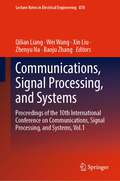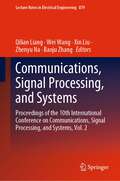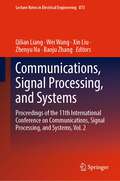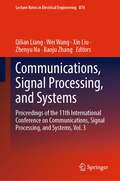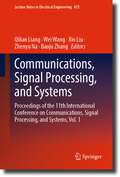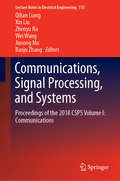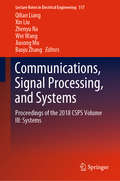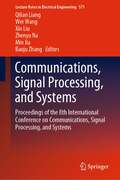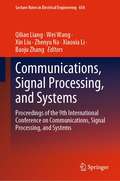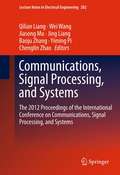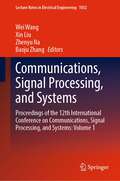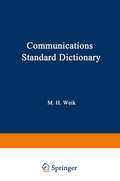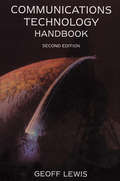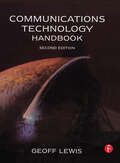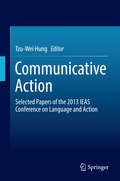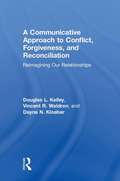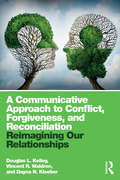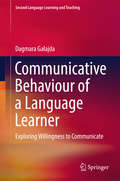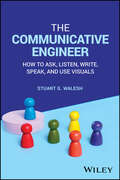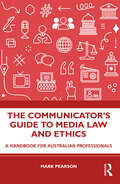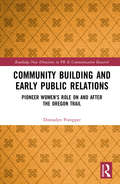- Table View
- List View
Communications, Signal Processing, and Systems: Proceedings of the 10th International Conference on Communications, Signal Processing, and Systems, Vol.1 (Lecture Notes in Electrical Engineering #878)
by Qilian Liang Wei Wang Xin Liu Zhenyu Na Baoju ZhangThis book brings together papers presented at the 2021 International Conference on Communications, Signal Processing, and Systems, which provides a venue to disseminate the latest developments and to discuss the interactions and links between these multidisciplinary fields. Spanning topics ranging from communications, signal processing and systems, this book is aimed at undergraduate and graduate students in Electrical Engineering, Computer Science and Mathematics, researchers and engineers from academia and industry as well as government employees (such as NSF, DOD and DOE).
Communications, Signal Processing, and Systems: Proceedings of the 10th International Conference on Communications, Signal Processing, and Systems, Vol. 2 (Lecture Notes in Electrical Engineering #879)
by Qilian Liang Wei Wang Xin Liu Zhenyu Na Baoju ZhangThis book brings together papers presented at the 2021 International Conference on Communications, Signal Processing, and Systems, which provides a venue to disseminate the latest developments and to discuss the interactions and links between these multidisciplinary fields. Spanning topics ranging from communications, signal processing and systems, this book is aimed at undergraduate and graduate students in Electrical Engineering, Computer Science and Mathematics, researchers and engineers from academia and industry as well as government employees (such as NSF, DOD and DOE).
Communications, Signal Processing, and Systems: Proceedings of the 11th International Conference on Communications, Signal Processing, and Systems, Vol. 2 (Lecture Notes in Electrical Engineering #873)
by Qilian Liang Wei Wang Xin Liu Zhenyu Na Baoju ZhangThis book brings together papers presented at the 2021 International Conference on Communications, Signal Processing, and Systems, Changbaishan, China, July 23-24, 2022, which provides a venue to disseminate the latest developments and to discuss the interactions and links between these multidisciplinary fields. Spanning topics ranging from communications, signal processing and systems, this book is aimed at undergraduate and graduate students in Electrical Engineering, Computer Science and Mathematics, researchers and engineers from academia and industry as well as government employees (such as NSF, DOD and DOE).
Communications, Signal Processing, and Systems: Proceedings of the 11th International Conference on Communications, Signal Processing, and Systems, Vol. 3 (Lecture Notes in Electrical Engineering #874)
by Qilian Liang Wei Wang Xin Liu Zhenyu Na Baoju ZhangThis book brings together papers presented at the 2022 International Conference on Communications, Signal Processing, and Systems, online, July 23-24, 2022, which provides a venue to disseminate the latest developments and to discuss the interactions and links between these multidisciplinary fields. Spanning topics ranging from communications, signal processing and systems, this book is aimed at undergraduate and graduate students in Electrical Engineering, Computer Science and Mathematics, researchers and engineers from academia and industry as well as government employees (such as NSF, DOD and DOE).
Communications, Signal Processing, and Systems: Proceedings of the 11th International Conference on Communications, Signal Processing, and Systems, Vol. 1 (Lecture Notes in Electrical Engineering #872)
by Qilian Liang Wei Wang Xin Liu Zhenyu Na Baoju ZhangThis book brings together papers presented at the 2022 International Conference on Communications, Signal Processing, and Systems, online, July 23-24, 2022, which provides a venue to disseminate the latest developments and to discuss the interactions and links between these multidisciplinary fields. Spanning topics ranging from communications, signal processing and systems, this book is aimed at undergraduate and graduate students in Electrical Engineering, Computer Science and Mathematics, researchers and engineers from academia and industry as well as government employees (such as NSF, DOD and DOE).
Communications, Signal Processing, and Systems: Proceedings of the 2018 CSPS Volume I: Communications (Lecture Notes in Electrical Engineering #515)
by Qilian Liang Wei Wang Jiasong Mu Baoju Zhang Xin Liu Zhenyu NaThis book brings together papers from the 2018 International Conference on Communications, Signal Processing, and Systems, which was held in Dalian, China on July 14–16, 2018. Presenting the latest developments and discussing the interactions and links between these multidisciplinary fields, the book spans topics ranging from communications, signal processing and systems. It is aimed at undergraduate and graduate electrical engineering, computer science and mathematics students, researchers and engineers from academia and industry as well as government employees.
Communications, Signal Processing, and Systems: Proceedings of the 2018 CSPS Volume III: Systems (Lecture Notes in Electrical Engineering #517)
by Qilian Liang Wei Wang Jiasong Mu Baoju Zhang Xin Liu Zhenyu NaThis book brings together papers from the 2018 International Conference on Communications, Signal Processing, and Systems, which was held in Dalian, China on July 14–16, 2018. Presenting the latest developments and discussing the interactions and links between these multidisciplinary fields, the book spans topics ranging from communications, signal processing and systems. It is aimed at undergraduate and graduate electrical engineering, computer science and mathematics students, researchers and engineers from academia and industry as well as government employees.
Communications, Signal Processing, and Systems: Proceedings of the 8th International Conference on Communications, Signal Processing, and Systems (Lecture Notes in Electrical Engineering #571)
by Qilian Liang Wei Wang Baoju Zhang Xin Liu Min Jia Zhenyu NaThis book brings together papers from the 2019 International Conference on Communications, Signal Processing, and Systems, which was held in Urumqi, China, on July 20–22, 2019. Presenting the latest developments and discussing the interactions and links between these multidisciplinary fields, the book spans topics ranging from communications to signal processing and systems. It is chiefly intended for undergraduate and graduate students in electrical engineering, computer science and mathematics, researchers and engineers from academia and industry, as well as government employees.
Communications, Signal Processing, and Systems: Proceedings of the 9th International Conference on Communications, Signal Processing, and Systems (Lecture Notes in Electrical Engineering #654)
by Qilian Liang Wei Wang Baoju Zhang Xin Liu Zhenyu Na Xiaoxia LiThis book brings together papers presented at the 2020 International Conference on Communications, Signal Processing, and Systems, which provides a venue to disseminate the latest developments and to discuss the interactions and links between these multidisciplinary fields. Spanning topics ranging from communications, signal processing and systems, this book is aimed at undergraduate and graduate students in Electrical Engineering, Computer Science and Mathematics, researchers and engineers from academia and industry as well as government employees (such as NSF, DOD and DOE).
Communications, Signal Processing, and Systems: The 2012 Proceedings of the International Conference on Communications, Signal Processing, and Systems (Lecture Notes in Electrical Engineering #202)
by Qilian Liang, Wei Wang, Jiasong Mu, Jing Liang, Baoju Zhang, Yiming Pi and Chenglin ZhaoCommunications, Signal Processing, and Systems is a collection of contributions coming out of the International Conference on Communications, Signal Processing, and Systems (CSPS) held August 2012. This book provides the state-of-art developments of Communications, Signal Processing, and Systems, and their interactions in multidisciplinary fields, such as audio and acoustic signal processing. The book also examines Radar Systems, Chaos Systems, Visual Signal Processing and Communications and VLSI Systems and Applications. Written by experts and students in the fields of Communications, Signal Processing, and Systems.
Communications, Signal Processing, and Systems: Proceedings Of The 2018 Csps Volume Iii: Systems (Lecture Notes In Electrical Engineering Ser. #517)
by Wei Wang Xin Liu Zhenyu Na Baoju ZhangCommunications Standard Dictionary
by Martin H. WeikCommunications * Standard Dictionary is a comprehensive compilation of terms and definitions used in communications and related fields. Communications is defined as the branch of science and technology concerned with the process of representing, transferring, and interpreting the meaning as signed to data by and among persons, places, or machines. Communication is defined as the transfer of information between a source (trans mitter, light source) and a sink (receiver, photodetector) over one or more chan nels in accordance with a protocol, and in a manner suitable for interpretation or comprehension by the receiver; or as a method or means of conveying informa tion of any kind from one person or place to another. In short, communications is a branch of science and technology, whereas com munication pertains to the actual transfer of information. Thus, the word com munication should be used as a modifier, as in communication center, communi cation deception, and communication line, just as in the field of electronics one speaks of electronic devices and electronic circuits.
Communications Technology Handbook
by Geoff LewisThis is the first point of reference for the communications industries. It offers an introduction to a wide range of topics and concepts encountered in the field of communications technology. Whether you are looking for a simple explanation, or need to go into a subject in more depth, the Communications Technology Handbook provides all the information you need in one single volume.This second edition has been updated to include the latest technology including: Video on DemandWire-less Distribution systemsHigh speed data transmission over telephone linesSmart cards and batteriesGlobal positioning Systems The contents are ordered initially by communications systems. This is followed by an introduction to each topic and goes on to provide more detailed information in alphabetical order. Every section contains an explanation of common terminology, and further references are provided. This approach offers flexible access to information for a variety of readers. Those who know little about communications professionals, the book constitutes a handy reference source and a way of finding out about related technologies. The book addresses an international audience by referring to all systems and standards throughout.This book has been revised to include new sections on: * Video on demand * Wire-less distribution systems * High speed data transmission over telephone lines * Smart cards * Global positioning systems * provides a basic understanding of a wide range of topics* offers a flexible approach for beginners and specialists alike * addresses an international audience by referring to all systems and standards throughout
Communications Technology Handbook
by Geoff LewisThis is the first point of reference for the communications industries. It offers an introduction to a wide range of topics and concepts encountered in the field of communications technology. Whether you are looking for a simple explanation, or need to go into a subject in more depth, the Communications Technology Handbook provides all the information you need in one single volume.This second edition has been updated to include the latest technology including: Video on DemandWire-less Distribution systemsHigh speed data transmission over telephone linesSmart cards and batteriesGlobal positioning Systems The contents are ordered initially by communications systems. This is followed by an introduction to each topic and goes on to provide more detailed information in alphabetical order. Every section contains an explanation of common terminology, and further references are provided. This approach offers flexible access to information for a variety of readers. Those who know little about communications professionals, the book constitutes a handy reference source and a way of finding out about related technologies. The book addresses an international audience by referring to all systems and standards throughout.This book has been revised to include new sections on: * Video on demand * Wire-less distribution systems * High speed data transmission over telephone lines * Smart cards * Global positioning systems * provides a basic understanding of a wide range of topics* offers a flexible approach for beginners and specialists alike * addresses an international audience by referring to all systems and standards throughout
Communicative Action: Selected Papers of the 2013 IEAS Conference on Language and Action
by Tzu-Wei HungThis book focuses on the connection between action and verbal communication, exploring topics such as the mechanisms of language processing, action processing, voluntary and involuntary actions, knowledge of language and assertion. Communication modelling and aspects of communicative actions are considered, along with cognitive requirements for nonverbal and verbal communicative action.Contributions from expert authors are organised into three parts in this book, focussing on language in communication, action and bodily awareness and sensorimotor interaction and language acquisition.Readers will discover various methods that have been employed in investigations presented here, including neurological experiment, computational modeling and logical and philosophical analysis.These diverse expert perspectives shed light on the extent to which a mechanism for processing actions also facilitates the processing of language and the authors’ work prompts further interdisciplinary investigation of the relationship between language and action.This book is written for readers from different academic backgrounds; from graduate students to established academics in disciplines ranging from neuroscience to psychology, philosophy, linguistics and beyond.Earlier versions of the selected essays in this book were presented at the 2013 IEAS Conference on Language and Action, held in Taipei, Taiwan.
A Communicative Approach to Conflict, Forgiveness, and Reconciliation: Reimagining our Relationships
by Douglas L. Kelley Vincent R. Waldron Dayna N. KloeberA Communicative Approach to Conflict, Forgiveness, and Reconciliation: Reimagining Our Relationships synthesizes communication and psychology scholarship that focuses on rebuilding ourselves and our relationships when things go "wrong". It provides fresh insights into the burgeoning body of forgiveness research, with an emphasis on community application and reconciliation. Written by award winning scholars in forgiveness communication, the book makes forgiveness and reconciliation research accessible to students in courses focused on personal relationships, conflict, and family studies.
A Communicative Approach to Conflict, Forgiveness, and Reconciliation: Reimagining Our Relationships (PDF)
by Douglas L. Kelley Vincent R. Waldron Dayna N. KloeberA Communicative Approach to Conflict, Forgiveness, and Reconciliation: Reimagining Our Relationships synthesizes communication and psychology scholarship that focuses on rebuilding ourselves and our relationships when things go "wrong". It provides fresh insights into the burgeoning body of forgiveness research, with an emphasis on community application and reconciliation. Written by award winning scholars in forgiveness communication, the book makes forgiveness and reconciliation research accessible to students in courses focused on personal relationships, conflict, and family studies.
A Communicative Approach to Conflict, Forgiveness, and Reconciliation: Reimagining Our Relationships
by Douglas L. Kelley Vincent R. Waldron Dayna N. KloeberA Communicative Approach to Conflict, Forgiveness, and Reconciliation: Reimagining Our Relationships synthesizes communication and psychology scholarship that focuses on rebuilding ourselves and our relationships when things go "wrong". It provides fresh insights into the burgeoning body of forgiveness research, with an emphasis on community application and reconciliation. Written by award winning scholars in forgiveness communication, the book makes forgiveness and reconciliation research accessible to students in courses focused on personal relationships, conflict, and family studies.
A Communicative Approach to Conflict, Forgiveness, and Reconciliation: Reimagining Our Relationships
by Douglas L. Kelley Vincent R. Waldron Dayna N. KloeberA Communicative Approach to Conflict, Forgiveness, and Reconciliation: Reimagining Our Relationships synthesizes communication and psychology scholarship that focuses on rebuilding ourselves and our relationships when things go "wrong". It provides fresh insights into the burgeoning body of forgiveness research, with an emphasis on community application and reconciliation. Written by award winning scholars in forgiveness communication, the book makes forgiveness and reconciliation research accessible to students in courses focused on personal relationships, conflict, and family studies.
Communicative Behaviour of a Language Learner: Exploring Willingness to Communicate (Second Language Learning and Teaching)
by Dagmara GałajdaThis book investigates and analyzes the way in which factors such as communication apprehension, self-perceived communicative competence and group dynamics influence the communicative behavior of a foreign-language learner. It also focuses on interpersonal communication, group communication and public speaking. Using selected models it characterizes and analyzes all types of communication with reference to communication in the language classroom, with a particular emphasis on the foreign-language context. The author also presents some conclusions and implications for both language teachers and language learners, as well as offering suggestions for further research in the field of classroom communication. The results of the study serve as a point of reference for teachers interested in the construct of willingness to communicate and other communication variables related to the issue of communication in a foreign language. The work also raises teachers' awareness of individual learner differences in the context of communication in the foreign-language classroom.
The Communicative Engineer: How to Ask, Listen, Write, Speak, and Use Visuals
by Stuart G. WaleshTHE COMMUNICATIVE ENGINEER Application-oriented communication guidebook designed for engineering students and practitioners to improve their asking, listening, writing, speaking, and use of visuals Practicing engineers spend about half their time communicating ideas, facts, and feelings but invest only a small part of their formal education learning how to communicate. The Communicative Engineer addresses this gap. When used as a textbook for students or resource for practitioners, this book shows engineers in all disciplines how to use five communication modes—asking, listening, writing, speaking, and visuals—to participate in or lead successful engineering projects and achieve professional success and significance. Written by a highly qualified author with six decades of relevant experience, The Communicative Engineer: Illustrates, using examples, the benefits of communication knowledge, skills, and attitudes (KSA) and the costs of poor communicationPresents communication fundamentals and goes well beyond theory by illustrating numerous applicationsDescribes the five modes of communication, including their pros and cons, and offers detailed advice on when and how to use themPrepares readers to use or participate in various communication forms such as interviews, letters, meeting minutes, memoranda, oral examinations, proposals, question and answer sessions, reports, resumes, speeches, and texts Profiles excellent engineer communicators to serve as exemplars and references memorable speeches from within and outside of engineering to provide examplesProvides thorough documentation of content for readers who want to dig deeper into selective aspects of communication Supplementing the scientific and technical education of engineers, The Communicative Engineer offers engineering students and practitioners in all disciplines the parallel communication KSA needed to fully realize their potential. Given technology’s ever-increasing role in society, the communicative engineer will be prepared to fill leadership roles.
The Communicative Engineer: How to Ask, Listen, Write, Speak, and Use Visuals
by Stuart G. WaleshTHE COMMUNICATIVE ENGINEER Application-oriented communication guidebook designed for engineering students and practitioners to improve their asking, listening, writing, speaking, and use of visuals Practicing engineers spend about half their time communicating ideas, facts, and feelings but invest only a small part of their formal education learning how to communicate. The Communicative Engineer addresses this gap. When used as a textbook for students or resource for practitioners, this book shows engineers in all disciplines how to use five communication modes—asking, listening, writing, speaking, and visuals—to participate in or lead successful engineering projects and achieve professional success and significance. Written by a highly qualified author with six decades of relevant experience, The Communicative Engineer: Illustrates, using examples, the benefits of communication knowledge, skills, and attitudes (KSA) and the costs of poor communicationPresents communication fundamentals and goes well beyond theory by illustrating numerous applicationsDescribes the five modes of communication, including their pros and cons, and offers detailed advice on when and how to use themPrepares readers to use or participate in various communication forms such as interviews, letters, meeting minutes, memoranda, oral examinations, proposals, question and answer sessions, reports, resumes, speeches, and texts Profiles excellent engineer communicators to serve as exemplars and references memorable speeches from within and outside of engineering to provide examplesProvides thorough documentation of content for readers who want to dig deeper into selective aspects of communication Supplementing the scientific and technical education of engineers, The Communicative Engineer offers engineering students and practitioners in all disciplines the parallel communication KSA needed to fully realize their potential. Given technology’s ever-increasing role in society, the communicative engineer will be prepared to fill leadership roles.
The Communicator's Guide to Media Law and Ethics: A Handbook for Australian Professionals
by Mark PearsonThis book offers an introduction to the key legal and ethical topics confronting Australian journalists and strategic communicators both at home and internationally and offers a suite of reflective techniques for navigating them. It starts by positioning morals, ethics, and the law in their historical and philosophical frameworks by tracing the evolution of free expression and professional media ethics. Media law and ethics are then contextualized in their modern international human rights framework. Readers are equipped with a skill set for reflecting on the law and ethics of professional media dilemmas – including mindful reflection, the Potter Box, journaling, concept mapping, and discussion. Such approaches are then applied to key topic areas, including free expression; reputation; confidentiality; privacy; justice; intellectual property; national security; discrimination and harassment; and conflicted interests. Each is examined in terms of its philosophical underpinnings, relationship to human rights, professional ethical context, international examples, legal principles, key Australian laws, legal cases, and strategies for applying reflective practice techniques. It concludes on a confident note – imploring communicators to engage in constructive and mindful strategic communication with the authority and confidence that results from a working knowledge of media law and ethics. This handbook is for professional communicators and students in all fields, but particularly in journalism, public relations, corporate communication, media relations, and marketing.
The Communicator's Guide to Media Law and Ethics: A Handbook for Australian Professionals
by Mark PearsonThis book offers an introduction to the key legal and ethical topics confronting Australian journalists and strategic communicators both at home and internationally and offers a suite of reflective techniques for navigating them. It starts by positioning morals, ethics, and the law in their historical and philosophical frameworks by tracing the evolution of free expression and professional media ethics. Media law and ethics are then contextualized in their modern international human rights framework. Readers are equipped with a skill set for reflecting on the law and ethics of professional media dilemmas – including mindful reflection, the Potter Box, journaling, concept mapping, and discussion. Such approaches are then applied to key topic areas, including free expression; reputation; confidentiality; privacy; justice; intellectual property; national security; discrimination and harassment; and conflicted interests. Each is examined in terms of its philosophical underpinnings, relationship to human rights, professional ethical context, international examples, legal principles, key Australian laws, legal cases, and strategies for applying reflective practice techniques. It concludes on a confident note – imploring communicators to engage in constructive and mindful strategic communication with the authority and confidence that results from a working knowledge of media law and ethics. This handbook is for professional communicators and students in all fields, but particularly in journalism, public relations, corporate communication, media relations, and marketing.
Community Building and Early Public Relations: Pioneer Women’s Role on and after the Oregon Trail (Routledge New Directions in PR & Communication Research)
by Donnalyn PompperFrom the start, women were central to a century of westward migration in the U.S. Community Building and Early Public Relations: Pioneer Women’s Role on and after the Oregon Trail offers a path forward in broadening PR's Caucasian/White male-gendered history in the U.S. Undergirded by humanist, communitarian, critical race theory, social constructionist perspectives, and a feminist communicology lens, this book analyzes U.S. pioneer women's lived experiences, drawing parallels with PR's most basic functions – relationship-building, networking, community building, boundary spanning, and advocacy. Using narrative analysis of diaries and reminiscences of women who travelled 2,000+ miles on the Oregon Trail in the mid-to-late 1800s, Pompper uncovers how these women filled roles of Caretaker/Advocate, Community Builder of Meeting Houses and Schools, served a Civilizing Function, offered Agency and Leadership, and provided Emotional Connection for Social Cohesion. Revealed also is an inevitable paradox as Caucasian/White pioneer women’s interactional qualities made them complicit as colonizers, forever altering indigenous peoples’ way of life. This book will be of interest to undergraduate and graduate PR students, PR practitioners, and researchers of PR history and social identity intersectionalities. It encourages us to expand the definition of PR to include community building, and to revise linear timeline and evolutionary models to accommodate voices of women and people of color prior to the twentieth century.
